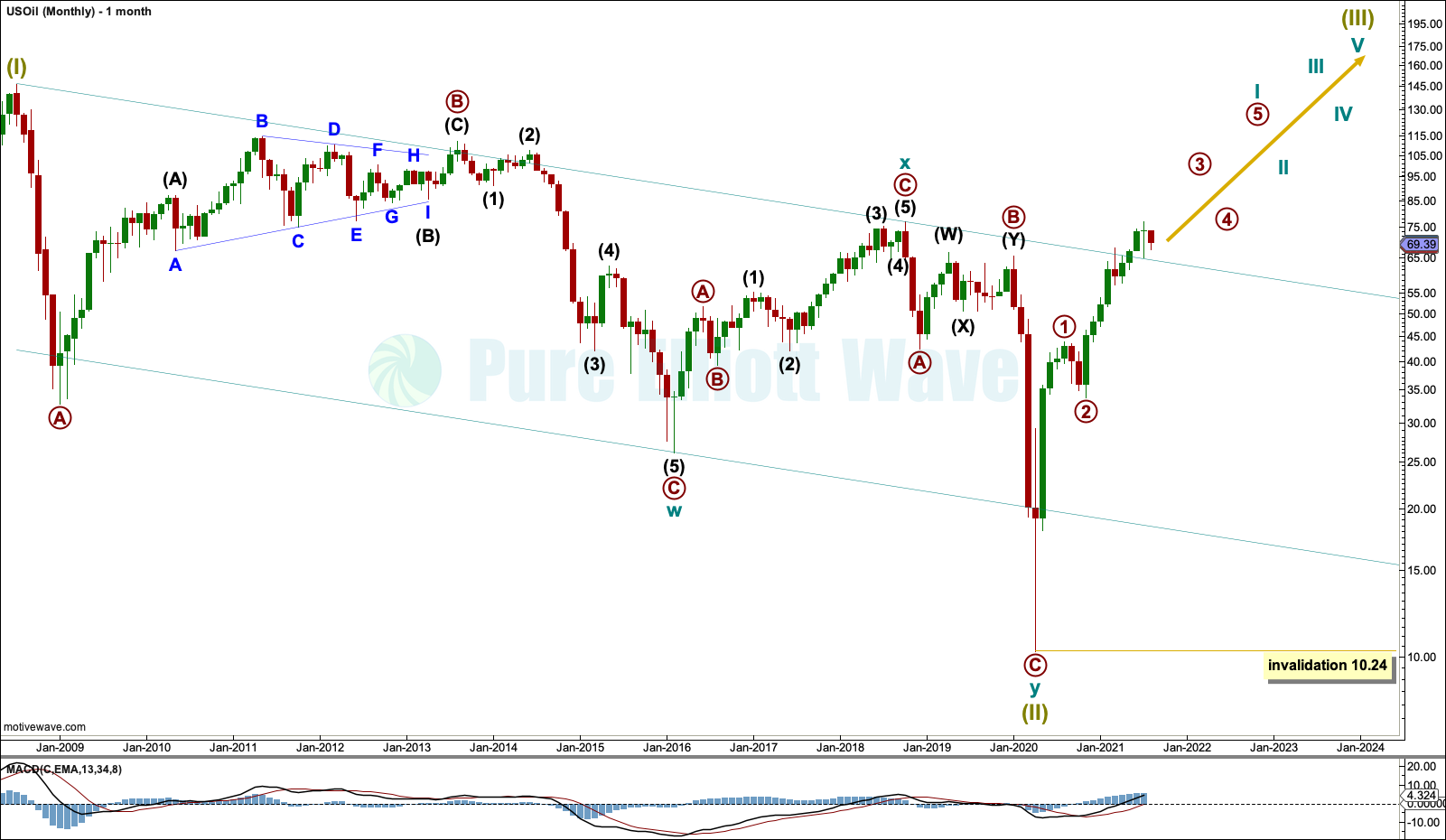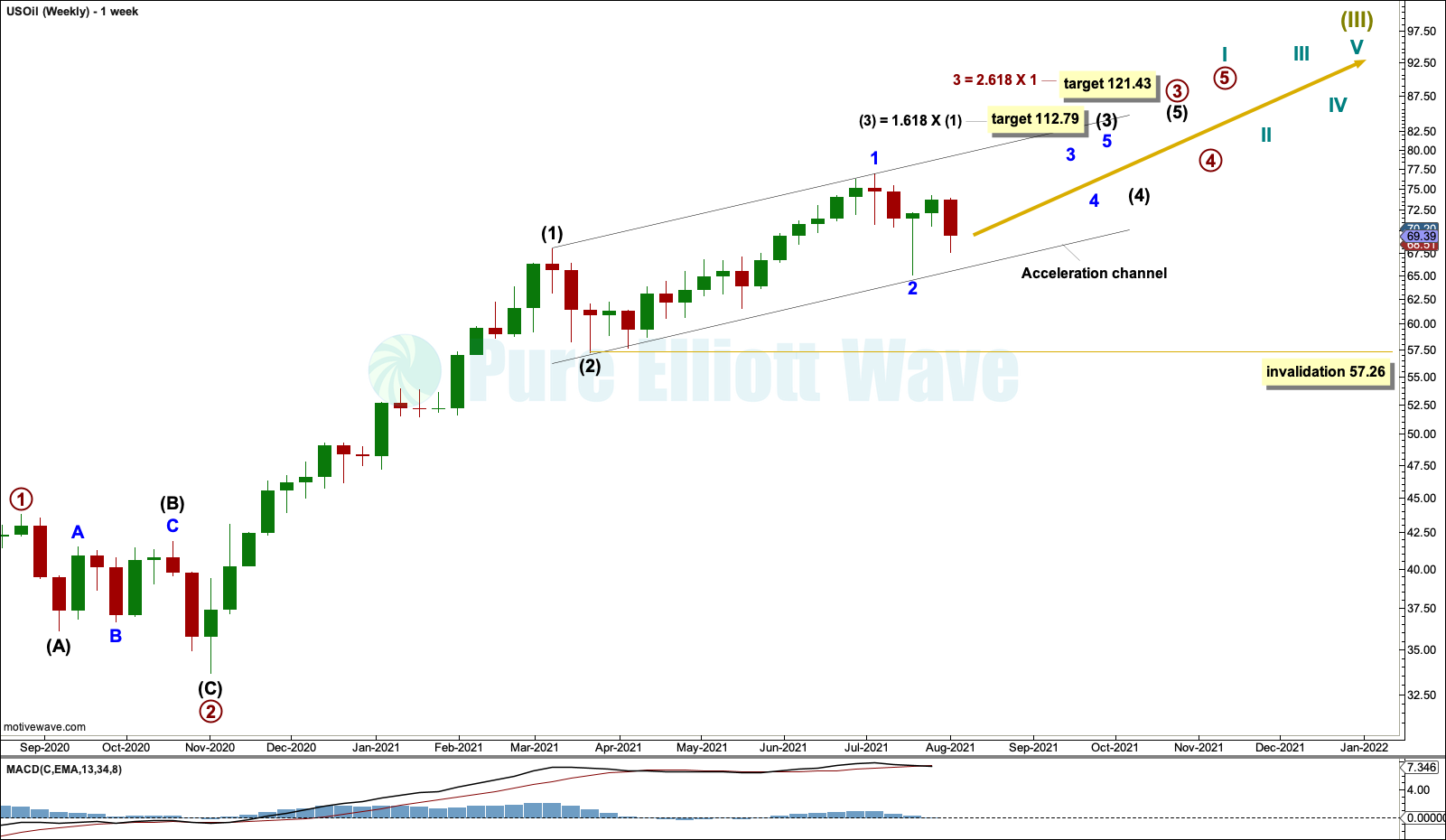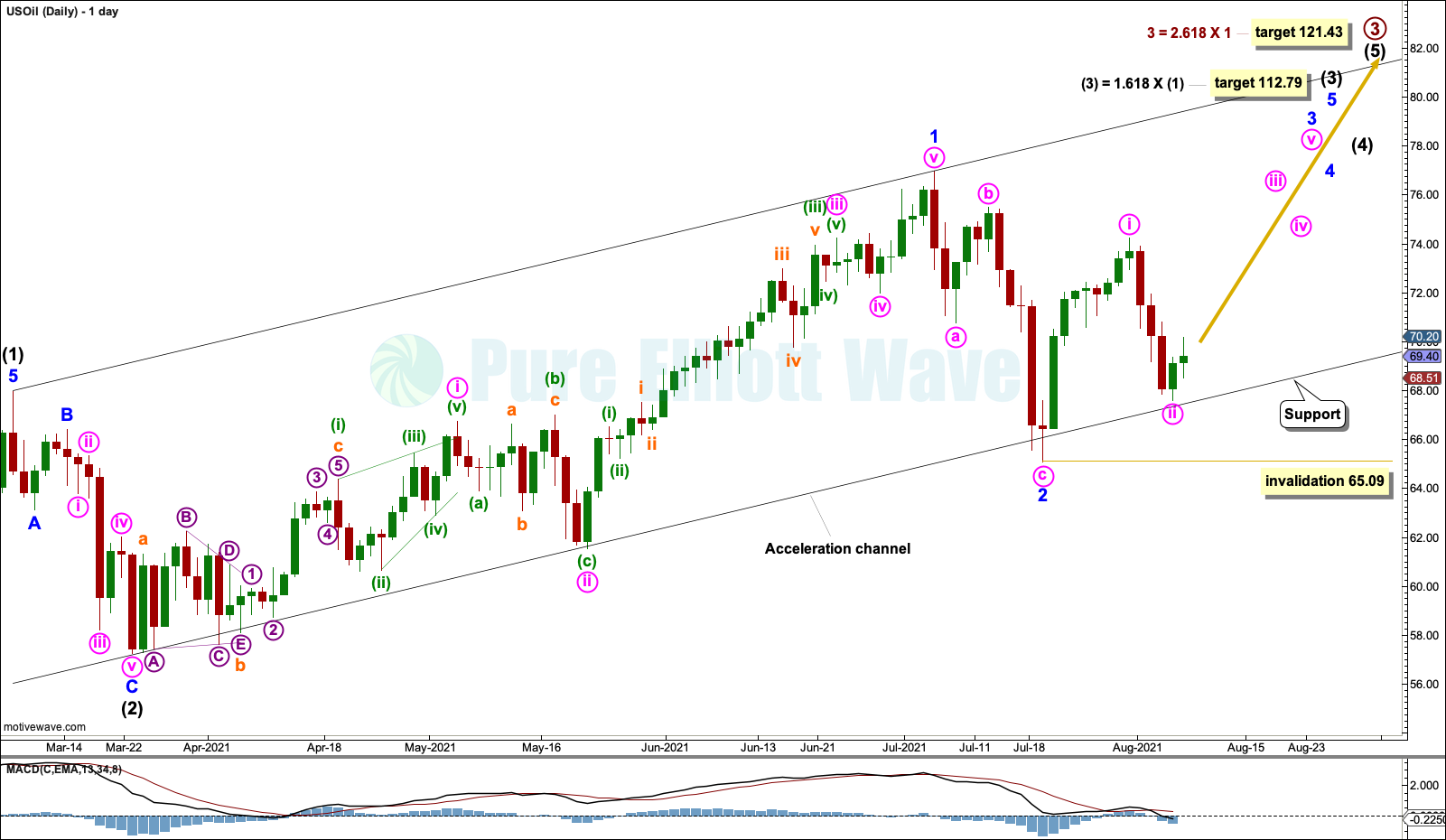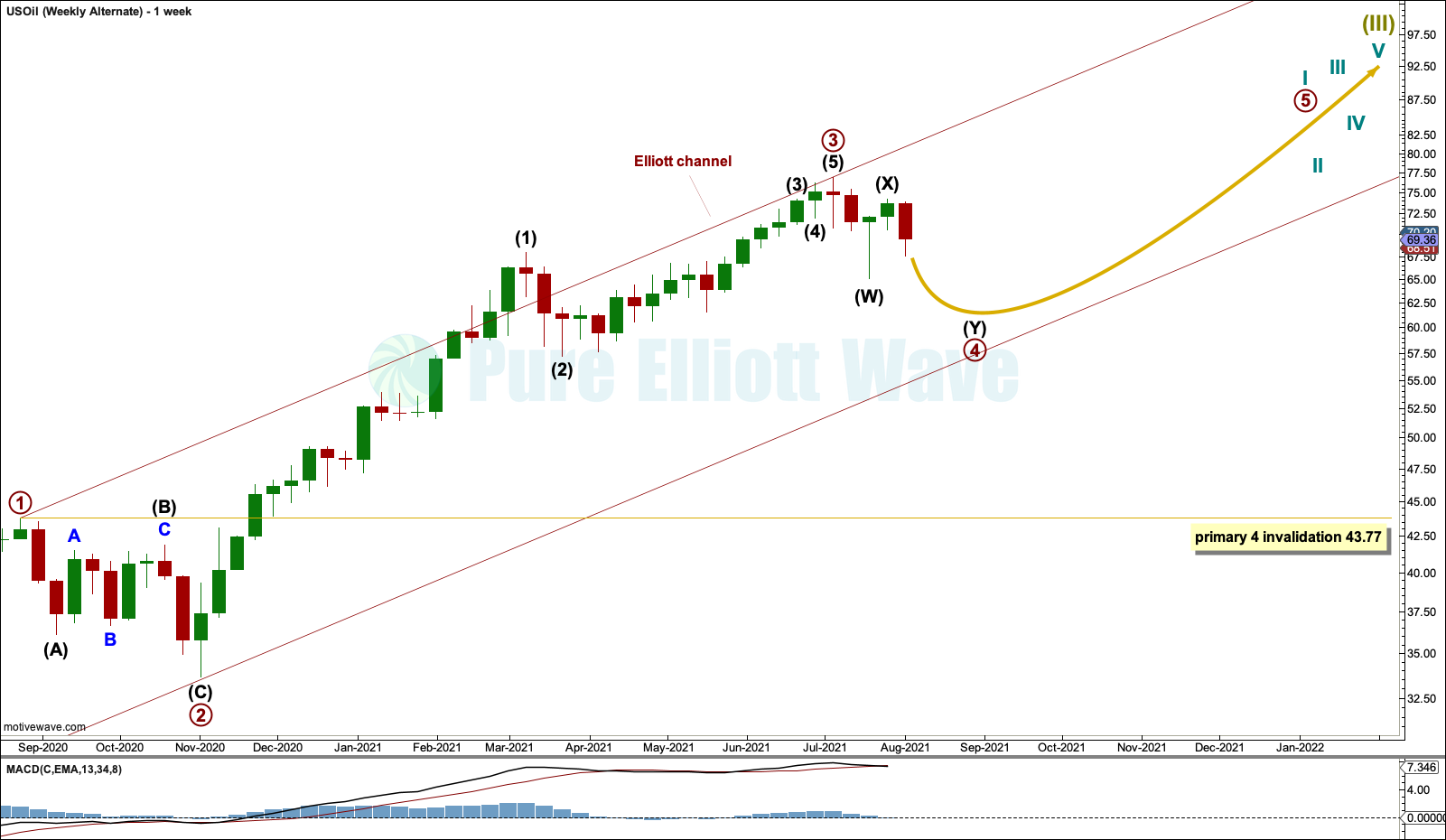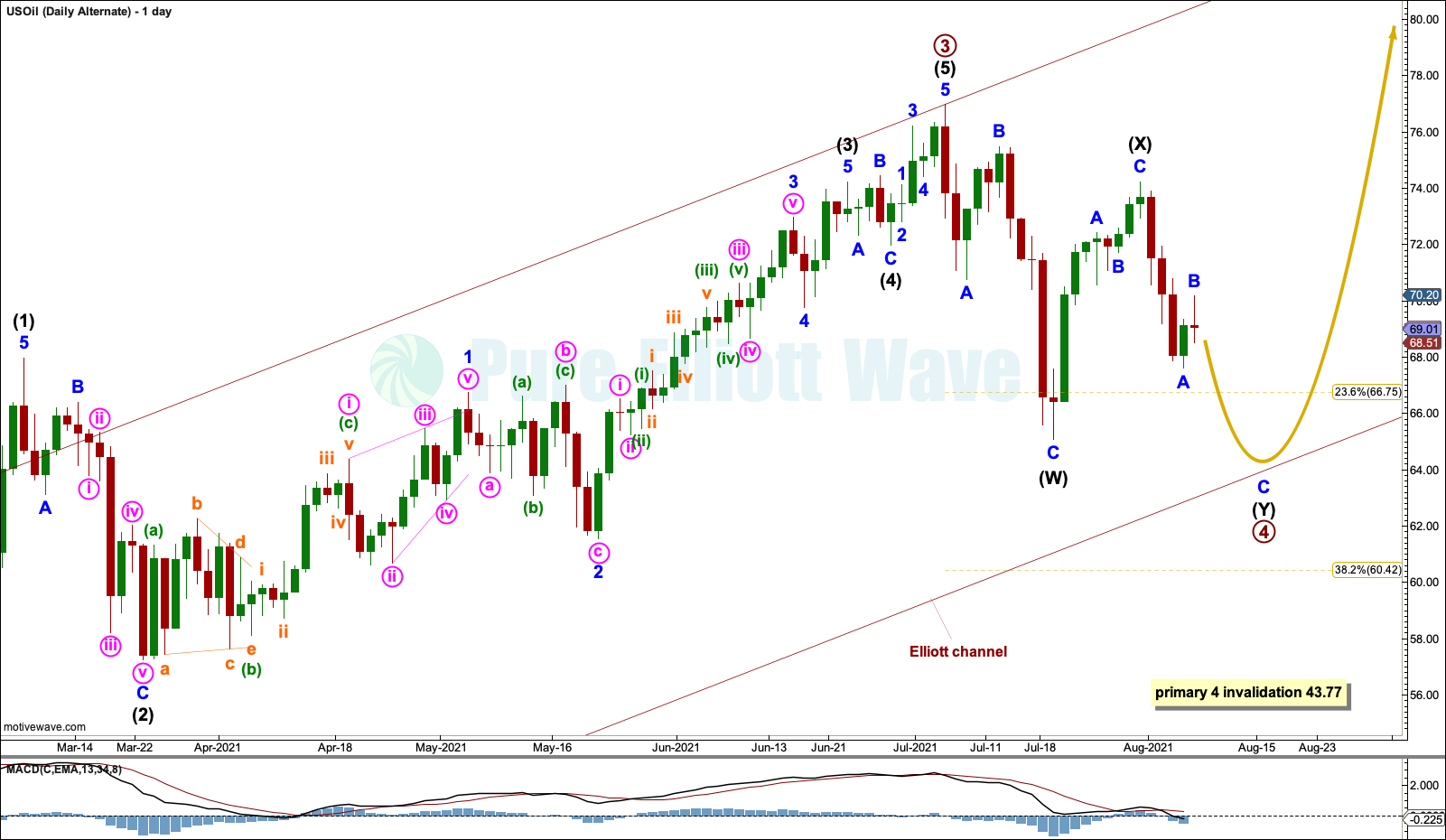US OIL: Elliott Wave and Technical Analysis | Charts – August 6, 2021
Downwards movement this week remains within the channel and above the invalidation point on the main Elliott wave count. The lower edge of the channel is providing support, so far.
The alternate Elliott wave count this week has a little support from classic technical analysis, particularly ADX, volume and candlesticks.
Summary: The main Elliott wave count expects upwards movement to resume to the next target at 112.79.
An alternate Elliott wave count allows for more downwards movement to end at support at the lower edge of a channel on the daily chart.
Oil may have found a major sustainable low in April 2020.
ELLIOTT WAVE COUNT
MONTHLY CHART
The basic Elliott wave structure is five steps forward and three steps back. This Elliott wave count expects that US Oil has completed a three steps back pattern, which began in July 2008. The Elliott wave count expects that the bear market for US Oil may now be over.
Following Super Cycle wave (II), which was a correction (three steps back), Super Cycle wave (III), which may have begun, should be five steps up when complete. Super Cycle wave (III) may last a generation and must make a new high above the end of Super Cycle wave (I) at 146.73.
A channel is drawn about Super Cycle wave (II): draw the first trend line from the start of cycle wave w to the end of cycle wave x, then place a parallel copy on the end of cycle wave w. This trend line is breached to the downside, which is a typical look for the end of a movement for a commodity.
The upper edge of the channel has now been breached by upwards movement. This trend line may now have provided support for the last pullback; if the current pullback is surprisingly deep, then this trend line may again be expected to provide strong support.
A new high above the high at 76.90 from October 2018 has been made. This is a significant new high and was expected from this wave count. Further confidence in a bull market for Oil may be had.
Super Cycle wave (III) may only subdivide as a five wave impulse. New trends for Oil usually start out very slowly with short first waves and deep time consuming second wave corrections. However, while this is a common tendency, it is not always seen and may not have been seen in this instance. The first reasonably sized pullback may be over already.
WEEKLY CHART
Super Cycle wave (III) must subdivide as an impulse.
Cycle wave I within Super Cycle wave (III) may be incomplete.
Within cycle wave I: Primary waves 1 and 2 may be complete, and primary wave 3 may only subdivide as an impulse.
Intermediate waves (1) and (2) within primary wave 3 may be complete. Minor wave 2 within intermediate wave (3) may not move beyond the start or minor wave 1 below 57.26.
Draw an acceleration channel about primary wave 3. Draw the first trend line from the end of intermediate wave (1) to the last high, then place a parallel copy on the end of intermediate wave (2). Keep redrawing the channel as price continues higher. The lower edge of the channel may provide support for pullbacks along the way up. On the weekly chart the channel is drawn on a semi-log scale, and on the daily chart below it is drawn on an arithmetic scale. Use the channel on both scales.
DAILY CHART
Minor wave 1 within intermediate wave (3) may be complete at the last high. The last pullback may be minor wave 2. Minor wave 2 may have ended about support at the lower edge of the acceleration channel.
Minor wave 3 may only subdivide as an impulse. Minute wave ii within the impulse may not move beyond the start of minute wave i below 65.09.
This wave count is very bullish. It expects a third wave at minor, intermediate and primary degree may have just begun. An increase in upwards momentum would be expected.
When third waves extend their subdivisions are also extended and take more time. It is normal to see the middle of an extended third wave begin with a series of first and second waves.
ALTERNATE WEEKLY CHART
It is possible that primary waves 1, 2 and 3 within cycle wave I are complete. If primary wave 3 was complete at the last high, then the last pullback may have been the start of primary wave 4.
Primary wave 3 exhibits no Fibonacci ratio to primary wave 1. Primary wave 3 at 43.32 is longer than primary wave 1, which was 33.53.
Primary wave 2 lasted 10 weeks and subdivided as a single zigzag. Primary wave 4 may subdivide as any Elliott wave structure; so far it will be labelled as a possible double zigzag, but this labelling may need to change as it unfolds.
Primary wave 4 should last a few more weeks to be in better proportion to primary wave 2. Primary wave 4 may not move into primary wave 1 price territory below 43.77.
Draw an Elliott channel about the impulse of primary wave 3. Draw the first trend line from the ends of primary waves 1 to 3, then place a parallel copy on the end of primary wave 2. Primary wave 4 may find support about the lower edge of this channel.
When the channel is drawn about primary wave 3 there is an overshoot at the upper edge for intermediate wave (1). It is normal to see an overshoot of the trend channel on the side of the direction of the trend, but it is normally the third wave within the third wave as this is normally the strongest portion of a third wave impulse. This wave count does not have a normal look with the channel.
ALTERNATE DAILY CHART
Primary wave 4 may unfold as any one of more than 23 possible corrective Elliott wave structures. So far it will be labelled as a possible double zigzag to move lower to find support about the lower edge of the Elliott channel, but it may also continue sideways as a combination, flat or triangle.
It would be most likely that primary wave 4 would not be over at the last low. It would look too brief in comparison to primary wave 2.
If primary wave 4 unfolds as a double zigzag as labelled, then it may end about support at the lower edge of the channel, which may be about 64.
TECHNICAL ANALYSIS
WEEKLY CHART
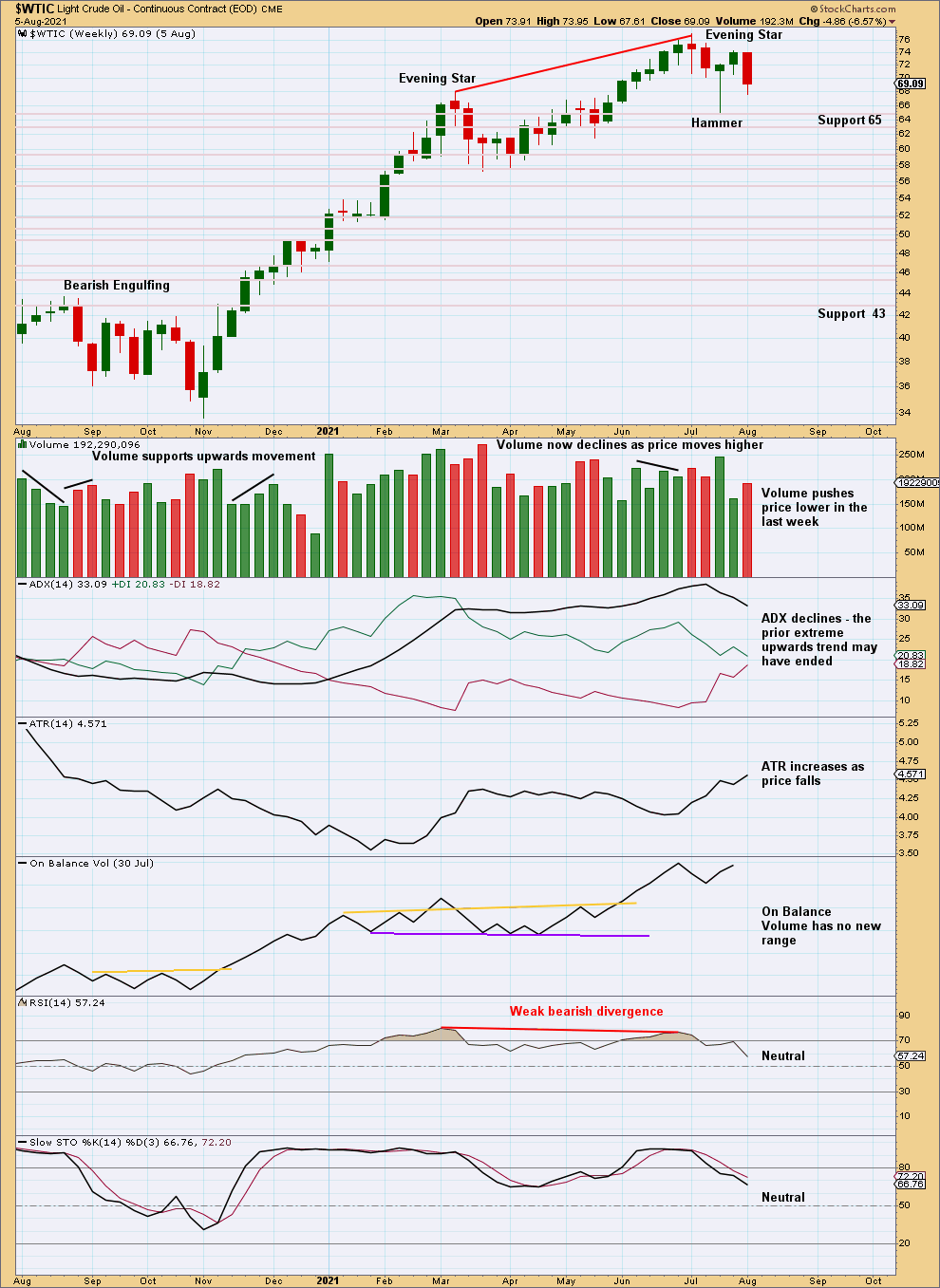
Click chart to enlarge. Chart courtesy of StockCharts.com.
At the last high, there was bearish divergence between price and RSI, ADX had reached extreme, and a bearish candlestick pattern in an Evening Star developed. A pullback or trend change would be expected given these conditions.
A Hammer candlestick pattern suggests the pullback may be over; this favours the main Elliott wave count. When this market has a strong trend, then extreme conditions may be sustained for a reasonable period of time while price moves a great distance.
A downwards week this week with support from volume suggests another test of support about 65 may occur.
DAILY CHART
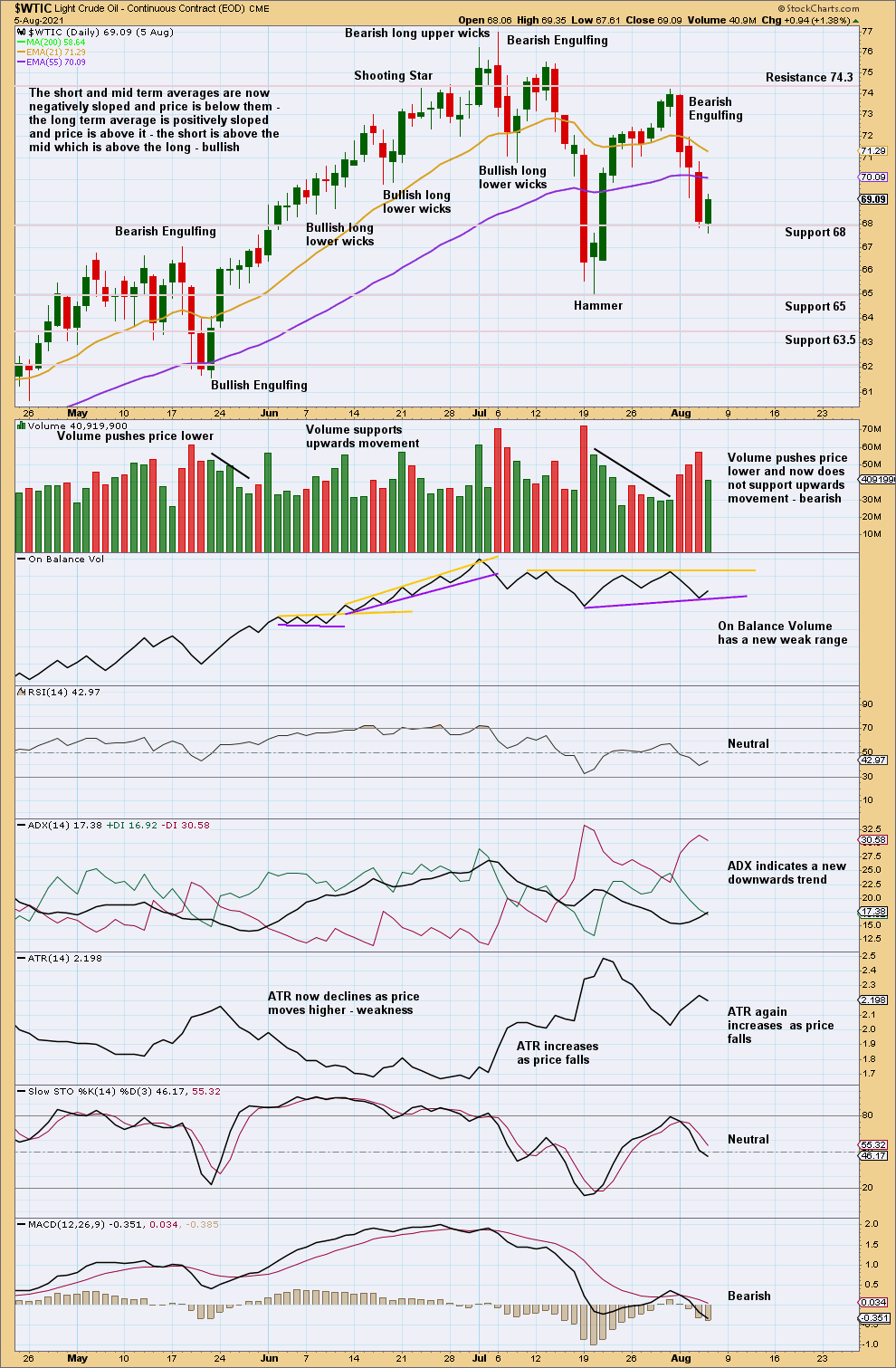
Click chart to enlarge. Chart courtesy of StockCharts.com.
The pullback continued until Stochastics reached oversold and price moved below support, to then turn up strongly. A Hammer candlestick pattern at the low suggests the pullback may be over. This supports the main Elliott wave count.
Now a downwards trend is indicated after price tested resistance at 74.3 and Stochastics almost reached overbought. RSI is neutral; there is plenty of room for a downwards trend to continue. If price closes below support at 65, then confidence in a downwards trend may be had. Both Elliott wave counts will remain possible while price remains above this point.
This chart slightly favours the alternate Elliott wave count this week.
Published @ 01:54 p.m. ET.
—
Careful risk management protects your investment account(s).
Follow my two Golden Rules:
1. Invest only funds you are prepared to lose entirely.
2. Always have an exit strategy for both directions; when or where to take profit on a winning investment, and when or where to close a losing investment.
—
New updates to this analysis are in bold.
—

